Hospital
for Tropical Diseases
St Pancras Way, NW1 0PE
Medical
dates:
Medical
character:
Specialist
After
WW1 the British Red Cross and the Order of St John of Jerusalem made a
gift to the Seamen's Hospital Society, enabling it to buy and
equip the Endsleigh
Palace Hotel at 25 Gordon Street as a hospital for tropical
diseases. The building had
been used previously by the Red Cross as a hospital for officers during
the war.
The London School of Tropical Medicine moved from the Albert Dock Hospital and opened as the Hospital for Tropical Diseases on 11th November 1920. It had 77 beds, admitting all those suffering from 'diseases peculiar to the tropics', with seamen and the poor receiving free treatment. From 1920 the Hospital shared the premises with the London School of Tropical Medicine, which later merged with the London School of Hygiene and became the London School of Hygiene and Tropical Medicine (LSHTM).
In 1929 the LSHTM moved to its new building in Keppel Street, enabling expansion of the Hospital. The vacated premises were altered to increase the patient accommodation from 56 to 76 beds. A new clinical pathology department was created, together with a lecture theatre for 120 students. The Hospital staff covered all specialties, including conditions of the ear, nose and throat, neurology, cardiology, diseases of the chest, ophthalmology and radiology. Tropical diseases had been gaining importance during the first half of the 20th century, as travellers to and from all over the world came to Britain.
At the outbreak of WW2 in 1939 the Hospital closed and was evacuated to the Dreadnought Hospital in Greenwich, where it had ten beds. The Out-patients Department continued to hold clinics twice a week, until a landmine severely damaged the building in 1941. The damaged premises were requisitioned by the Ministry of Works and the Out-patients Department transferred to the LSHTM.
By this time the government was aware of the urgent need for training in tropical medicine and a committee had been appointed by the Secretary of State for Colonies to draw up plans for a new hospital for tropical diseases.
In 1943 the committee recommended Greenwich as the site for an 'Imperial Hospital for Tropical Diseases' with 150 beds which would be a centre 'worthy of the British Empire with its vast tropical responsibilities'; nurses would be trained for service in the many parts of the Empire. However, it was decided that the new hospital should be near the LSHTM and should provide postgraduate training.
In 1945 the Hospital for Tropical Diseases moved from the Dreadnought Hospital to a temporary home at 23 Devonshire Street. However, the premises were limited (the Hospital had only 48 beds) and inadequate for teaching. The Hospital had tried and failed to get back its old building in Gordon Street, and the Ministry of Health refused to allow extension of the Devonshire Street premises because of the post-war shortage of steel and other materials.
In 1948 at the advent of the NHS, the Secretary of State, Aueurin Bevan, proposed the development of a tropical diseases unit within the University College of London Hospital Group. After much discussion, in 1949 University College Hospital offered vacant premises (the maternity block built in 1939) at St Pancras Hospital in St Pancras Way as a site for the new Hospital for Tropical Diseases.
The Hospital moved to its new home in 1951, becoming part of the NHS and thus ending its 130-year association with the Seamen's Hospital Society. It was opened officially that same year by the Duchess of Kent, on Empire Day (24th May). In 1954 it had 68 beds, an Out-Patients Clinic, a Pathology Department, laboratories and lecture rooms for postgraduate students.
In 1998 it moved to new purpose-built premises on the second floor of the Mortimer Market Centre in Capper Street.
The London School of Tropical Medicine moved from the Albert Dock Hospital and opened as the Hospital for Tropical Diseases on 11th November 1920. It had 77 beds, admitting all those suffering from 'diseases peculiar to the tropics', with seamen and the poor receiving free treatment. From 1920 the Hospital shared the premises with the London School of Tropical Medicine, which later merged with the London School of Hygiene and became the London School of Hygiene and Tropical Medicine (LSHTM).
In 1929 the LSHTM moved to its new building in Keppel Street, enabling expansion of the Hospital. The vacated premises were altered to increase the patient accommodation from 56 to 76 beds. A new clinical pathology department was created, together with a lecture theatre for 120 students. The Hospital staff covered all specialties, including conditions of the ear, nose and throat, neurology, cardiology, diseases of the chest, ophthalmology and radiology. Tropical diseases had been gaining importance during the first half of the 20th century, as travellers to and from all over the world came to Britain.
At the outbreak of WW2 in 1939 the Hospital closed and was evacuated to the Dreadnought Hospital in Greenwich, where it had ten beds. The Out-patients Department continued to hold clinics twice a week, until a landmine severely damaged the building in 1941. The damaged premises were requisitioned by the Ministry of Works and the Out-patients Department transferred to the LSHTM.
By this time the government was aware of the urgent need for training in tropical medicine and a committee had been appointed by the Secretary of State for Colonies to draw up plans for a new hospital for tropical diseases.
In 1943 the committee recommended Greenwich as the site for an 'Imperial Hospital for Tropical Diseases' with 150 beds which would be a centre 'worthy of the British Empire with its vast tropical responsibilities'; nurses would be trained for service in the many parts of the Empire. However, it was decided that the new hospital should be near the LSHTM and should provide postgraduate training.
In 1945 the Hospital for Tropical Diseases moved from the Dreadnought Hospital to a temporary home at 23 Devonshire Street. However, the premises were limited (the Hospital had only 48 beds) and inadequate for teaching. The Hospital had tried and failed to get back its old building in Gordon Street, and the Ministry of Health refused to allow extension of the Devonshire Street premises because of the post-war shortage of steel and other materials.
In 1948 at the advent of the NHS, the Secretary of State, Aueurin Bevan, proposed the development of a tropical diseases unit within the University College of London Hospital Group. After much discussion, in 1949 University College Hospital offered vacant premises (the maternity block built in 1939) at St Pancras Hospital in St Pancras Way as a site for the new Hospital for Tropical Diseases.
The Hospital moved to its new home in 1951, becoming part of the NHS and thus ending its 130-year association with the Seamen's Hospital Society. It was opened officially that same year by the Duchess of Kent, on Empire Day (24th May). In 1954 it had 68 beds, an Out-Patients Clinic, a Pathology Department, laboratories and lecture rooms for postgraduate students.
In 1998 it moved to new purpose-built premises on the second floor of the Mortimer Market Centre in Capper Street.
Present status (January
2008)
The building is presumably vacant.
Update: March 2013
The building is owned by the Camden and Islington NHS Foundation Trust, who use it for mixed health-related services and administrative offices.
The building is presumably vacant.
Update: March 2013
The building is owned by the Camden and Islington NHS Foundation Trust, who use it for mixed health-related services and administrative offices.
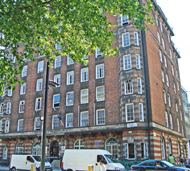
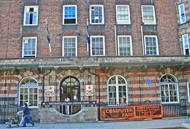
The first home of the Hospital at the Endsleigh Palace Hotel, 25 Gordon Square, is now occupied by University College London Union.

Its second home at 23 Devonshire Street, from 1945 until 1951.
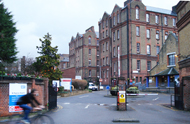
Entry to the St Pancras Hospital campus from St Pancras Way.
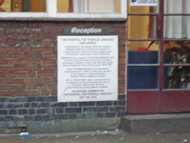
Notice announcing that the Hospital for Tropical Diseases (HTD) has moved.

The former HTD building as seen from the old St Pancras graveyard. It has now become part of the Huntley Centre, and is used by Camden and Islington NHS Foundation Trust for some of their adult in-patient wards (personal communication: Marc Oesterdahl, London).

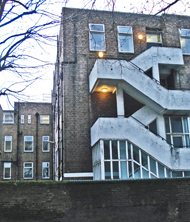
The building, as seen looking westwards
from Granary Street.
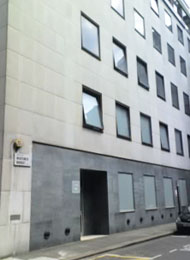
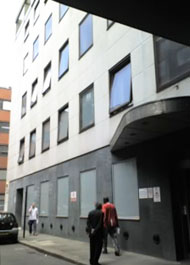
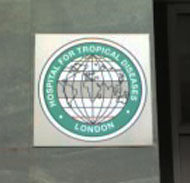 The Mortimer Market Centre
The Mortimer Market CentreCook GC 1992 From the Greenwick Hulks to Old St. Pancras: a History of Tropical Disease in London. London, Athlone Press.
Cook GC, Webb AJ 1990 Early history of tropical medicine in London. Journal of the Royal Society of Medicine 83, 38-41.
Fairley NH 1952 The Hospital for Tropical Diseases (UCH), London. UCH Magazine 37, 1-6.
Cook GC 2007 Disease in the Merchant Navy: A History of the Seamen's Hospital Society. Oxford, Radcliffe.
http://hansard.millbanksystems.com (1)
http://hansard.millbanksystems.com (2)
http://himetop.wikidotcom
http://rcnarchive.rcn.org.uk
www.gresham.ac.uk
www.thehtd.org
Return to home page